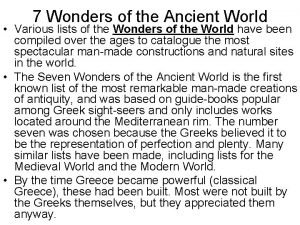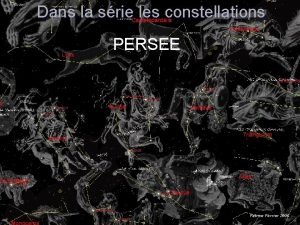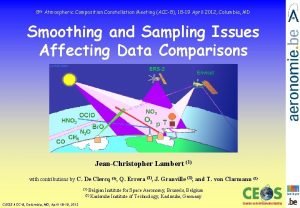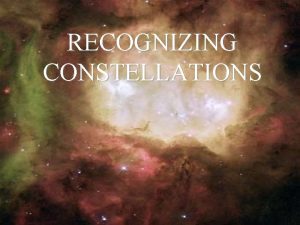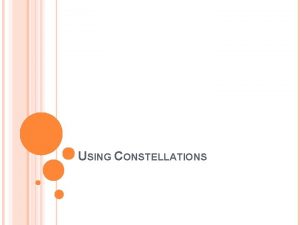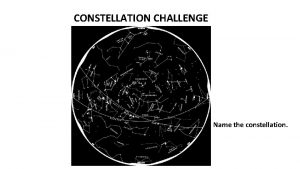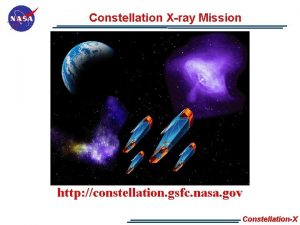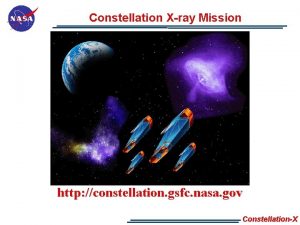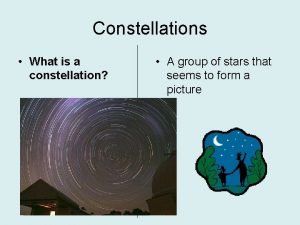Origins of Constellations Ancient constellations Constellation names we












- Slides: 12


Origins of Constellations Ancient constellations: • Constellation names we use derive from ancient Mesopotamia (modern day Iraq) • Others were added by the Babylonians, Egyptians, and Greeks. “Modern” constellations • 40 more were added by 1600 s • IAU officially defined 88 constellation boundaries in 1928 EVERY culture around the world has their own constellations Asterisms – named groups of stars that are NOT constellations ex: Big Dipper, Great Square Stars that make up constellations are all different distances from our Earth and Sun.

Star Names • The "common" names derive from ancient Arabic, and often have meanings – EX: • Rigel = leg • Betelgeuse = armpit of the giant • Deneb = tail • Altair = bird

Star Names • in 1603, the first "modern" naming system was developed by Johann Bayer, using: – the Greek alphabet for the brightness of the star – the Latin name of the constellation – EX: the brightest star in Orion (Betelguese) is also called a Orionis, the 2 nd brightest, is called b Orionis – one problem with this system is that some stars vary their brightness - Betelgeuse is NOT always brighter than Rigel! • There are over 10 different systems that are/have been used for naming stars

The Many Names of Betelgeuse • • • Alpha Orionis 58 Ori HR 2061 HD 39801 SAO 113271 BD+07 1055 HIP 27989 H 6 ADS 4506 WDS 05552+0724 TYC 0129 -1873 -1

Star Brightnesses - the Magnitude Scale • Introduced by Hipparchos (160 - 127 BC) – Divided the stars into 6 classes – brightest stars were 1 st magnitude – faintest stars were 6 th magnitude (unaided eye) – larger the magnitude, the fainter the star! • Today it is similar, but more mathematical, logarithmic scale – 1 st magnitude stars are 100 x brighter than 6 th magnitude stars – 1 magnitude difference = 2. 512 x difference in brightness, so – A 1 st mag star is 2. 5 times brighter than a 2 nd mag star, and a 1 st mag star is 2. 5 times brighter than a 3 rd mag star

Star Brightnesses - the Magnitude Scale • formalizing the mathematics has produced stars with negative magnitudes (Sirius = -1. 42) • Magnitude scale has been extended to all astronomical objects

Scientific Models • way of representing an object, process, or behavior, to make it more understandable • Can be: – a physical object (globe) – a mathematical formula (F = ma) – a conceptual idea • Doesn’t have to be correct in order to be useful!

Celestial Sphere Model of Universe • • • Earth-center (geocentric) Stars orbit the earth, attached to a huge sphere Pivots above the N and S poles (NCP & SCP) Half way between, above Earth’s equator is the: Celestial Equator – divides the northern sky from the southern sky – Passes through East and West points • Fully developed by about 200 B. C. • Believed to be true until around 1550

Rotation vs Revolution • Rotation is: – Spinning – Earth rotates once every: • Revolution – Orbiting – Earth revolves around the Sun once every:

Sun’s Apparent Motion • Sun appears to slowly move Eastward along the ecliptic • Over one year, it traces out the ecliptic • Plane of Earth’s orbit around the Sun • Plane of the solar system

Sun’s Apparent Motion • Planets also move Eastward along the ecliptic • 12 constellations the ecliptic passes through are the zodiac
 Halloween has its origins in which ancient celtic festival
Halloween has its origins in which ancient celtic festival Ancient rome and the origins of christianity
Ancient rome and the origins of christianity Macedonian phalanx
Macedonian phalanx 7 wonders of the ancient world names
7 wonders of the ancient world names Ancient and modern communication
Ancient and modern communication Ancient india vs ancient china
Ancient india vs ancient china Canis major facts
Canis major facts Constellation de persée
Constellation de persée Constellation confusion worksheet
Constellation confusion worksheet Constellation
Constellation Smallest constellation
Smallest constellation Imaginary constellation
Imaginary constellation Current gps constellation
Current gps constellation



